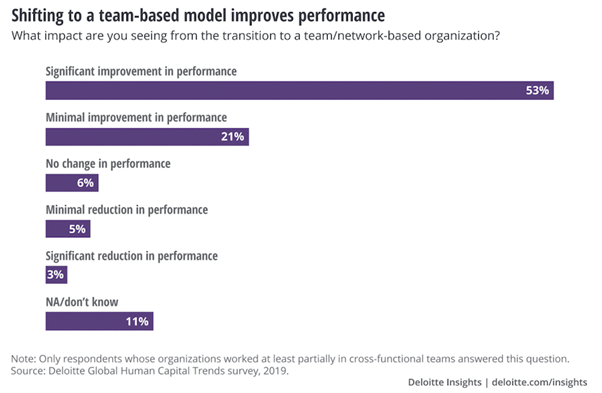There’s rarely any scope for scalability in manufacturing if departments work in silo—but things have changed. Both digital transformation and advanced thought leadership have introduced cross-functionality to bring diverse and targeted perspectives to work. Cross-functional collaboration involves bringing together individuals with knowledge, experience, and expertise from multiple fields into one. Cross-functional teams in a manufacturing setting can address a series of issues, from talent shortages to increasing efficiency.
Why are Cross-Functional Teams the Need of the Hour?
There’s a reason why cross-functionality is the need of the hour in a manufacturing setting. We are looking at a global smart manufacturing market that’s expected to grow to $658.41 billion in 2029 (13.1% CAGR). Naturally, for smart manufacturing companies to enable productivity in a way that fosters greater internal communication and collaboration, as well as creativity support improvements to products and services, cross-functional teams are a viable option. In the image below, we can see how cross-functional teams can work together.
 Source: SketchBubble
Source: SketchBubble
The Era of Internet of Things (IoT) Necessitates Cross-Functionality
While many think of the IoT as a union of hardware and software, the IoT economy in a smart factory setting is far more complicated. To oversee an end-to-end IoT process—which by nature is a network of interrelated responsibilities, stakeholders, and functions—cross-functional teams can smoothen the rough edges out.
For instance, software engineers, hardware designers, solution architects, and even analysts can cross-functionally imagine newer solutions and ways to oversee the IoT process. IoT also makes it easier to track machine usage and foresee malfunctions. Workers can thus arrange their workflow well and respond quickly.
IoT data also enhances the supply chain's ability to move information, components, and goods. For instance, by transporting goods from the manufacturer to the consumer, sensors installed in delivery vehicles can help manufacturers and logistic centers plan better routes and provide more precise arrival estimates. How does it help? According to Accenture, the lack of cross-functional collaboration costs return on investment (ROI) and revenue growth, especially in the context of digital transformations like smart factories.
Kaizen and Lean Manufacturing
A big change like smart factory transformation can be broken into smaller pieces and take a kaizen-centered culture to have a sustained, waste-free manufacturing output. Naturally, workflow automation can enable the Kaizen approach to enhance productivity and efficiency, and reduce waste.
As the guiding principle of kaizen outlines, “Speak with data, manage by facts.” A data-centric approach—which is a core principle of smart transformation—could become the backbone of cross-functional teams. Cross-functionality aims at continuous improvement, which, in spirit, aligns with kaizen and lean manufacturing. So, tackling something as big as smart factory transformation could be effectively and efficiently handled by cross-functional teams, while enabling a Kaizen-centered culture for sustaining perfect workflows.
Data-Heavy Centers and Integrations
Cross-functional teams can ensure a factory can make the most of data insights. By emphasizing team collaboration on data strategy, collection, validation, and activation rather than leaving these responsibilities to individual teams, a cross-functional approach to handling data can be achieved.
For plant managers and their teams, having real-time access to information about the activities on the shop floor can be a gamechanger. For instance, smart manufacturing platforms may identify production problems as soon as they occur, alert operators, maintenance teams, and plant management, and promptly send personnel to address the problems.
It goes without saying that, to meet contemporary customer demands and implement autonomous operations, manufacturers must continue to demonstrate their relevance by utilizing emerging technology trends. For any data-heavy center, smart implementation needs to integrate with a manufacturing unit’s security protocols, connect seamlessly across the entire supply chain, and extract sensor data into the cloud for analytics. Additionally, scalability is necessary for a project of this size because the volume of data will only increase. The cross-functional approach would include individuals from various data-driven teams within an organization, such as marketing, product, and data science or business intelligence (BI), as well as app developers and data engineers with an understanding of the technical requirements.
Improved Productivity and Morale
A Gartner report said that 90% of the board of directors think that the recent COVID-19 crisis increases the need for cross-functional teams. And, at a time when COVID-19 cropped up issues of decreased morale and inconsistent productivity, cross-functionality can come to aid.
When it comes to teamwork, many plant managers are attempting to instill new behaviors in their workforce. Smart factory transformation is disruptive in nature, so a cross-functional culture is touted to increase workforce productivity—especially since a smart factory setting demands an immaculate workflow. In a similar strain, workforce morale is boosted when workflow is streamlined and cross-functionally distributed.
 Source: Deloitte
Source: Deloitte
Cross-functional teams not only deliver individual milestones more successfully, but they also get to know coworkers from other departments—workers they may have never met otherwise. Therefore, cross-functional collaboration brings together individuals from different functions, which enhances the overall organizational culture.
Conclusion
Cross-functionality creates a synchronized interdependency, which is critical for smart factories and ecosystems. Synchronous collaboration is still a crucial component of contemporary manufacturing companies. Cross-functionality disrupts the status quo of “groupthink” and stimulates the flow of ideas. Additionally, sharing knowledge broadens everyone's horizons and improves problem-solving abilities. All of these result in clever and original solutions that increase client satisfaction, cementing success in modern industries.




